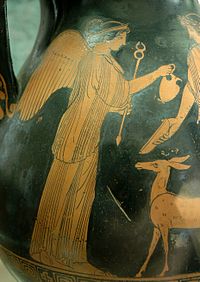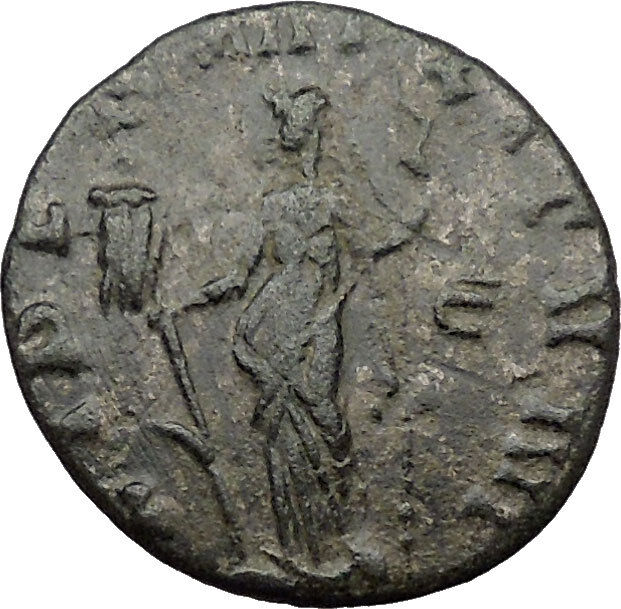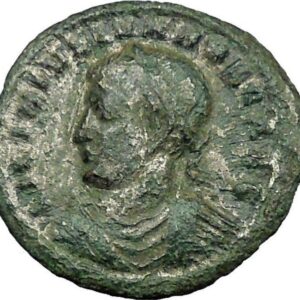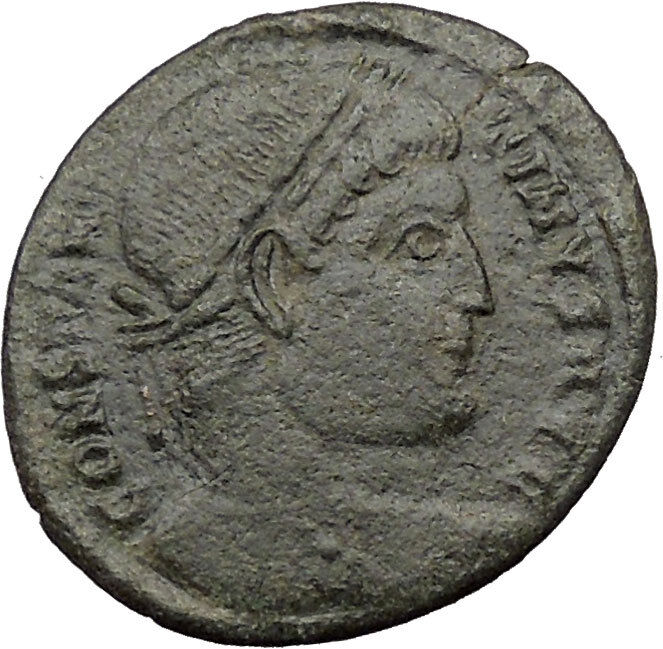|
Aurelian – Roman Emperor: 270-275 A.D. –
Bronze Antoninianus 21mm (3.93 grams) Struck circa 270-275 A.D.
Reference: Possibly Unpublished.
IMPAVRELIANVSAVG – Radiate, draped and cuirassed bust right.
FELICITPO Exe: T – Felicitas standing left, holding caduceus and scepter
You are bidding on the exact item pictured,
provided with a Certificate of Authenticity and Lifetime Guarantee of
Authenticity.
The caduceus from
Greek
“herald’s staff” is the staff carried by
Hermes
in
Greek mythology
. The same staff was also borne
by heralds in general, for example by
Iris
, the messenger of
Hera. It is a short staff entwined by two
serpents
, sometimes surmounted by wings. In
Roman iconography it was often depicted being carried in the left hand of
Mercury
, the messenger of the gods, guide of
the dead and protector of merchants, shepherds, gamblers, liars, and thieves.
As a symbolic object it represents Hermes (or the Roman Mercury), and by
extension trades, occupations or undertakings associated with the god. In later
Antiquity
the caduceus provided the basis for
the
astrological symbol
representing the
planet Mercury
. Thus, through its use in
astrology
and
alchemy
, it has come to denote the
elemental metal
of the same name.
By extension of its association with Mercury/Hermes, the caduceus is also a
recognized symbol of commerce and negotiation, two realms in which balanced
exchange and reciprocity are recognized as ideals.[4][5]
This association is ancient, and consistent from the Classical period to modern
times. The caduceus is also used as a symbol representing printing, again by
extension of the attributes of Mercury (in this case associated with writing and
eloquence).
The caduceus is sometimes mistakenly used
as a symbol of medicine and/or medical practice
,
especially in
North America
, because of widespread confusion
with the traditional medical symbol, the
rod of Asclepius
, which has only a single snake
and no wings.
The term kerukeion denoted any herald’s staff, not necessarily
associated with Hermes in particular.[7]
Lewis Richard Farnell
(1909) in his study of
the cult of Hermes assumed that the two snakes had simply developed out of
ornaments of the shepherd’s crook used by heralds as their staff.[8]
This view has been rejected by later authors pointing to parallel iconography in
the Ancient Near East. It has been argued that the staff or wand entwined by two
snakes was itself representing a god in the pre-anthropomorphic era. Like the
herm
or
priapus
, it would thus be a predecessor of the
anthropomorphic Hermes of the classical era.
Ancient Near East
William Hayes Ward
(1910) discovered that
symbols similar to the classical caduceus sometimes appeared on
Mesopotamian cylinder seals
. He suggested the
symbol originated some time between 3000 and 4000 BCE, and that it might have
been the source of the Greek caduceus.[10]
A.L. Frothingham incorporated Dr. Ward’s research into his own work, published
in 1916, in which he suggested that the prototype of Hermes was an “Oriental
deity of Babylonian extraction” represented in his earliest form as a snake god.
From this perspective, the caduceus was originally representative of Hermes
himself, in his early form as the Underworld god
Ningishzida
, “messenger” of the “Earth Mother”.[11]
The caduceus is mentioned in passing by
Walter Burkert
[12]
as “really the image of copulating snakes taken over from Ancient Near Eastern
tradition”.
In Egyptian iconography, the
Djed pillar is depicted as containing a snake in a frieze of the
Dendera Temple complex
.
The rod of Moses
and the
brazen serpent
are frequently compared to the
caduceus, especially as Moses is acting as a messenger of God to the
Pharaoh
at the point in the narrative where he
changes his staff into a serpent.[13]
Classical antiquity
Mythology
The
Homeric hymn
to Hermes relates how Hermes
offered his lyre fashioned from a tortoise shell as compensation for the
cattle he stole
from his half brother
Apollo
. Apollo in return gave Hermes the
caduceus as a gesture of friendship.[14]
The association with the serpent thus connects Hermes to
Apollo
, as later the serpent was associated
with Asclepius
, the “son of Apollo”.[15]
The association of Apollo with the serpent is a continuation of the older
Indo-European
dragon
-slayer motif.
Wilhelm Heinrich Roscher
(1913) pointed out
that the serpent as an attribute of both Hermes and Asclepius is a variant of
the “pre-historic semi-chthonic serpent hero known at Delphi as
Python
“, who in classical mythology is slain by
Apollo.[16]
One Greek myth of origin
of the caduceus is part of the
story of Tiresias
,[17]
who found two snakes copulating and killed the female with his staff. Tiresias
was immediately turned into a woman, and so remained until he was able to repeat
the act with the male snake seven years later. This staff later came into the
possession of the god Hermes, along with its transformative powers.
Another myth suggests that Hermes (or Mercury) saw two serpents entwined in
mortal combat. Separating them with his wand he brought about peace between
them, and as a result the wand with two serpents came to be seen as a sign of
peace.[18]
In Rome, Livy
refers to the caduceator who
negotiated peace arrangements under the diplomatic protection of the caduceus he
carried.
Iconography
In some vase paintings ancient depictions of the Greek kerukeion are
somewhat different from the commonly seen modern representation. These
representations feature the two snakes atop the staff (or rod), crossed to
create a circle with the heads of the snakes resembling horns. This old graphic
form, with an additional crossbar to the staff, seems to have provided the basis
for the graphical
sign of Mercury
(☿) used in
Greek astrology
from Late Antiquity.[19]
Use in alchemy
and occultism
As the symbol of both the
planet
and the
metal
named for Mercury, the caduceus became an
important symbol in
alchemy
.
The
crucified serpent
was also revived as an
alchemical symbol for
fixatio
, and
John Donne
(Sermons 10:190) uses
“crucified Serpent” as a title of
Jesus Christ
.
Symbol of commerce
A simplified variant of the caduceus is to be found in dictionaries,
indicating a “commercial term” entirely in keeping with the association of
Hermes with commerce. In this form the staff is often depicted with two winglets
attached and the snakes are omitted (or reduced to a small ring in the middle).[20]
The Customs Service of the former
German Democratic Republic
employed the
caduceus, bringing its implied associations with thresholds, translators, and
commerce, in the service medals they issued their staff.
Misuse as symbol
of medicine
It is relatively common, especially in the United States, to find the
caduceus, with its two snakes and wings, used as a symbol of medicine instead of
the correct rod of Asclepius, with only a single snake. This usage is erroneous,
popularised largely as a result of the adoption of the caduceus as its insignia
by the
US Army medical corps
in 1902 at the insistence
of a single officer (though there are conflicting claims as to whether this was
Capt. Frederick P. Reynolds or Col. John R. van Hoff).[21][22]
The rod of Asclepius is the dominant symbol for professional healthcare
associations in the United States. One survey found that 62% of professional
healthcare associations used the rod of Asclepius as their symbol.[23]
The same survey found that 76% of commercial healthcare organizations used the
Caduceus symbol. The author of the study suggests the difference exists because
professional associations are more likely to have a real understanding of the
two symbols, whereas commercial organizations are more likely to be concerned
with the visual impact a symbol will have in selling their products.
The initial errors leading to its adoption and the continuing confusion it
generates are well known to medical historians. The long-standing and abundantly
attested historical associations of the caduceus with commerce, theft,
deception, and death are considered by many to be inappropriate in a symbol used
by those engaged in the healing arts.[22]
This has occasioned significant criticism of the use of the caduceus in a
medical context.
Lucius Domitius Aurelianus
(September
9, 214
or 215 –September or October 275), known in English as Aurelian,
Roman
Emperorr
(270–275), was the second of several highly successful
“soldier-emperors” who helped the
Roman
Empire
regain its power during the latter part of the third century and the
beginning of the fourth.
During his reign, the Empire was reunited in its
entirety, following fifteen years of rebellion, the loss of two-thirds of its
territory to break-away empires (the
Palmyrene Empire
in the east and the
Gallic Empire
in the west) and devastating barbarian invasions. His
successes started the end of the empire’s
Crisis of the Third Century
.
//
Aurelian was an upwardly-mobile soldier who was eventually appointed
commander of the cavalry by Claudius II. With the aid of a sympathetic army he
revolted against the accession of Quintillus and a civil war was avoided when
the latter committed suicide following the growing popularity of his rival.
Aurelian was then hailed as emperor by the Senate and the rest of the legions
alike. His first mission was to strengthen the army by the introduction of the
strictest reforms and discipline as well as quelling the various uprisings that
had broken out over the last two decades. He thus spent the next five years
until cut down by his own Praetorian Guard at the height of his glory. It seems
Aurelian’s personal secretary, after being reprimanded by the emperor for
attempted extortion, felt an execution would follow. To guard against this
possibility, he concocted a story about Aurelian intending to execute his
personal guard and then rushed to share with them this manufactured evidence.
Naturally, afraid for their lives, they entered the emperor’s quarters and
effected a preemptive strike. Somehow or other it was soon afterward found out
that the formerly beloved emperor had no such motives and his secretary himself
was swiftly executed for treason. When news reached Rome of what had happened
Aurelian’s wife seems to have actually been left nominally in power while a new
emperor was selected, a period that may have lasted several months. Although
history is a little hazy in this matter, it would mark the first and only time a
Roman empress explicitly ruled the empire.
Rise to power
Aurelian was born in
Dacia ripensis
or
Sirmium
(now
Sremska Mitrovica
,
Serbia
),
to an obscure provincial family; his father was tenant to a senator named
Aurelius, who gave his name to the family.
Aurelian served as a general in several wars, and his success ultimately made
him the right-hand man and dux equitum (cavalry commander) of the army of
Emperor Gallienus
. In 268, his cavalry routed the powerful cavalry force of the
Goths
at the
Battle of Naissus
and broke the back of the most fearsome invasion of Roman
territory since Hannibal
. According to one source, Aurelian participated in the
assassination of Gallienus (268), and supported
Claudius II
for the purple.
Two years later, when Claudius died his brother
Quintillus
seized power with support of the Senate. With an act typical of the
Crisis of the Third Century
, the army refused to recognize the new emperor,
preferring to support one of its own commanders: Aurelian was proclaimed emperor
in September 270 by the
legions
in Sirmium. Aurelian defeated Quintillus’ troops, and was recognized emperor by
the Senate after Quintillus’ death. The claim that Aurelian was chosen by
Claudius on his death bed
can be dismissed as propaganda; later, probably in 272, Aurelian put his own
dies imperii the day of Claudius’ death, thus implicitly considering
Quintillus a
usurper
.
With his base of power secure, he now turned his attention to Rome’s greatest
problems — recovering the vast territories lost over the previous two decades,
and reforming the res publica.
Conqueror and reformer
In 248, Emperor
Philipp
had celebrated the millennium of the city of Rome with great and
expensive ceremonies and games, and the empire had given a tremendous proof of
self-confidence. In the following years, however, the empire had to face a huge
pressure from external enemies, while, at the same time, dangerous civil wars
threatened the empire from within, with a large number of usurpers weakening the
strength of the state. Also the economical substrate of the state, the
agriculture and the commerce, suffered from the disruption caused by the
instability. On top of this an epidemic swept through the Empire around 250,
greatly diminishing manpower both for the army and for agriculture. The end
result was that the empire could not endure the blow of the capture of Emperor
Valerian
in 260: the eastern provinces found their protectors in the rulers
of the city of Palmyra
, in
Syria
Palmyrene Empire
, a separate entity from the Roman Empire, successful
against the Persian threat; the western provinces, those facing the
limes
of the
Rhine
seceded,
forming a third, autonomous state within the territories of the Roman Empire,
which is now known as
Gallic Empire
; the emperor, in Rome, was occupied with the internal menaces
to his power and with the defence of
Italia
and the Balkans. This was the situation faced by Gallienus and
Claudius, and the problems Aurelian had to deal with at the beginning of his
rule.
Reunification of the empire
The first actions of the new emperor were aimed at strengthening his own
position in his territories. Late in 270, Aurelian campaigned in northern
Italia
against the
Vandals
,
Juthungi
,
and Sarmatians
, expelling them from Roman territory. To celebrate these
victories, Aurelian was granted the title of Germanicus Maximus.
The authority of the emperor was challenged by several
usurpers
—
Septimius
,
Urbanus
,
Domitianus
, and the rebellion of
Felicissimus
— who tried to exploit the sense of insecurity of the empire
and the overwhelming influence of the armies in Roman politics. Aurelian, being
an experienced commander, was aware of the importance of the army, and his
propaganda, known through his coinage, shows he wanted the support of the
legions.
Defeat of the Alamanni
The burden of the northern barbarians was not yet over, however. In 271, the
Alamanni
moved towards Italia, entering the Po plain and sacking the villages; they
passed the
Po River
, occupied
Placentia
and moved towards Fano
.
Aurelian, who was in Pannonia to control
Vandals
‘
withdrawal, quickly entered Italia, but his army was defeated in an
ambush near Placentia
(January 271). When the news of the defeat arrived in
Rome, it caused great fear for the arrival of the barbarians. But Aurelian
attacked the Alamanni camping near the
Metaurus River
,
defeating them in the
Battle of Fano
, and forcing them to re-cross the Po river; Aurelian finally
routed them at
Pavia
. For this, he received the title Germanicus Maximus. However,
the menace of the German people remained high as perceived by the Romans, so
Aurelian resolved to build the walls that became known as the
Aurelian Walls
around
Rome.
The emperor led his legions to the Balkans, where he defeated and routed the
Goths beyond the Danube, killing the Gothic leader
Cannabaudes
, and assuming the title of Gothicus Maximus. However, he
decided to abandon the province of
Dacia
,
on the exposed north bank of the Danube, as too difficult and expensive to
defend. He reorganised a new province of Dacia south of the Danube, inside the
former Moesia
,
called Dacia Ripensis, with
Serdica
as the capital.
Conquest of the Palmyrene Empire
In 272, Aurelian turned his attention to the lost eastern provinces of the
empire, the so-called “Palmyrene
Empire” ruled by Queen
Zenobia
from
the city of Palmyra
.
Zenobia had carved out her own empire, encompassing
Syria
, Palestine
, Egypt
and large parts of
Asia Minor
. In the beginning, Aurelian had been recognized as emperor, while
Vaballathus
, the son of Zenobia, hold the title of rex and
imperator (“king” and “supreme military commander”), but Aurelian decided to
invade the eastern provinces as soon as he felt strong enough.
Asia Minor was recovered easily; every city but
Byzantium
Tyana
surrendered to him with little resistance. The fall of Tyana lent itself to a
legend; Aurelian to that point had destroyed every city that resisted him, but
he spared Tyana after having a vision of the great 1st century philosopher
Apollonius of Tyana
, whom he respected greatly, in a dream. Apollonius
implored him, stating: “Aurelian, if you desire to rule, abstain from the blood
of the innocent! Aurelian, if you will conquer, be merciful!” Whatever the
reason, Aurelian spared Tyana. It paid off; many more cities submitted to him
upon seeing that the emperor would not exact revenge upon them. Within six
months, his armies stood at the gates of Palmyra, which surrendered when Zenobia
tried to flee to the
Sassanid Empire
. The “Palmyrene Empire” was no more. Eventually Zenobia and
her son were captured and forced to walk on the streets of Rome in his triumph.
After a brief clash with the Persians and another in Egypt against usurper
Firmus
, he was
forced to return to Palmyra in 273 when that city rebelled once more. This time,
Aurelian allowed his soldiers to sack the city, and Palmyra never recovered from
this. More honors came his way; he was now known as Parthicus Maximus and
Restitutor Orientis (“Restorer of the East”).
Conquest of the Gallic Empire
In 274, the victorious emperor turned his attention to the west, and the “Gallic
EmpireeTetricus
was willing to abandon his throne and allow Gaul and Britain to return to the
empire, but could not openly submit to Aurelian. Instead, the two seem to have
conspired so that when the armies met at
Châlons-en-Champagne
that autumn, Tetricus simply deserted to the Roman camp
and Aurelian easily defeated the Gallic army facing him. Tetricus was rewarded
for his part in the conspiracy with a high-ranking position in Italy itself.
Aurelian returned to Rome and won his last honorific from the Senate —
Restitutor Orbis (“Restorer of the World”). In four years, he had secured
the frontiers of the empire and reunified it, effectively giving the empire a
new lease on life that lasted 200 years.
Reformations
Aurelian was a reformer, and settled many important functions of the imperial
apparatus, including the economy and the religion. He also restored many public
buildings, re-organized the management of the food reserves, set fixed prices
for the most important goods, and prosecuted misconduct by the public officers.
Religious reform
Aurelian strengthened the position of the Sun god,
Sol
(invictus)
or Oriens, as the main divinity of the Roman pantheon. His intention was to give
to all the peoples of the Empire, civilian or soldiers, easterners or
westerners, a single god they could believe in without betraying their own gods.
The center of the cult was a new temple, built in 271 in
Campus Agrippae
in Rome, with great decorations financed by the spoils
of the Palmyrene Empire. Aurelian did not persecute other religions. However,
during his short rule, he seemed to follow the principle of “one god, one
empire”, that was later adopted to a full extent by
Constantine
. On some coins, he appears with the title deus et dominus
natus (“God and born ruler”), also later adopted by Diocletian.
Lactantius
argued that Aurelian would have outlawed all the other gods if he had had enough
time.
Felicissimus’ rebellion and coinage reform
Aurelian’s reign records the only uprising of mint workers. The
rationalis
Felicissimus
, mintmaster at Rome, revolted against Aurelian. The revolt
seems to have been caused by the fact that the mint workers, and Felicissimus
first, were accustomed to stealing the silver used for the coins and producing
coins of inferior quality. Aurelian wanted to erase this practice, and put
Felicissimus under trial. The rationalis incited the mintworkers to
revolt: the rebellion spread in the streets, even if it seems that Felicissimus
was killed immediately, possibly executed. The Palmirene rebellion in Egypt had
probably reduced the
grain supply to Rome
, thus disaffecting the population with respect to the
emperor. This rebellion also had the support of some senators, probably those
who had supported the election of
Quintillus
,
and thus had something to fear from Aurelian. Aurelian ordered the urban
cohorts, reinforced by some regular troops of the imperial army, to attack the
rebelling mob: the resulting battle, fought on the
Caelian hill
, marked the end of the revolt,
even if at a high price (some sources give the figure, probably exaggerated, of
7,000 casualties). Many of the rebels were executed; also some of the rebelling
senators were put to death. The mint of Rome was closed temporarily, and the
institution of several other mints caused the main mint of the empire to lose
its hegemony.
antoninianii
containing 5% silver. They bore the mark XXI
(or its Greek numerals form KA), which meant that twenty of such
coins would contain the same silver quantity of an old silver
denarius
.
Considering that this was an improvement over the previous situation gives an
idea of the severity of the economic situation Aurelian faced. The emperor
struggled to introduce the new “good” coin by recalling all the old “bad” coins
prior to their introduction.
Death
In 275, Aurelian marched towards Asia Minor, preparing another campaign
against the Sassanids: the deaths of Kings
Shapur I
(272) and Hormizd I
(273) in quick succession, and the rise to power of a weakened
ruler (Bahram I),
set the possibility to attack the Sassanid Empire.
On his way, the emperor suppressed a revolt in Gaul — possibly against
Faustinus, an officer or usurper of Tetricus — and defeated barbarian marauders
at Vindelicia
(Germany).
However, Aurelian never reached Persia, as he was murdered while waiting in
Thrace to cross into Asia Minor. As an administrator, Aurelian had been very
strict and handed out severe punishments to corrupt officials or soldiers. A
secretary of Aurelian (called Eros by y
Zosimus
) had
told a lie on a minor issue. In fear of what the emperor might do, he forged a
document listing the names of high officials marked by the emperor for
execution, and showed it to collaborators. The notarius Mucapor and other
high-ranking officiers of the
Praetorian Guard
, fearing punishment from the Emperor, murdered him in
September of 275, in Caenophrurium
, Thrace (modern Turkey).
Aurelian’s enemies in the Senate briefly succeeded in passing
damnatio memoriae
on the emperor, but this was reversed before the end
of the year and Aurelian, like his predecessor Claudius II, was deified as
Divus Aurelianus.
Ulpia Severina, wife of Aurelian and
Augusta
since 274, is said to have held the imperial role during the
short interregnum before the election of
Marcus Claudius Tacitus
to the purple.
|










